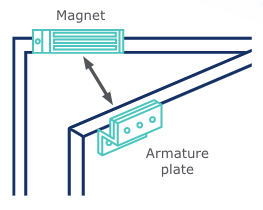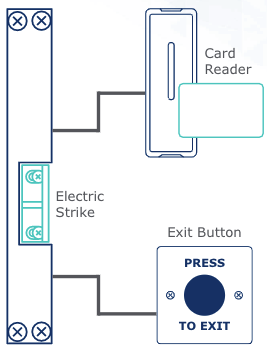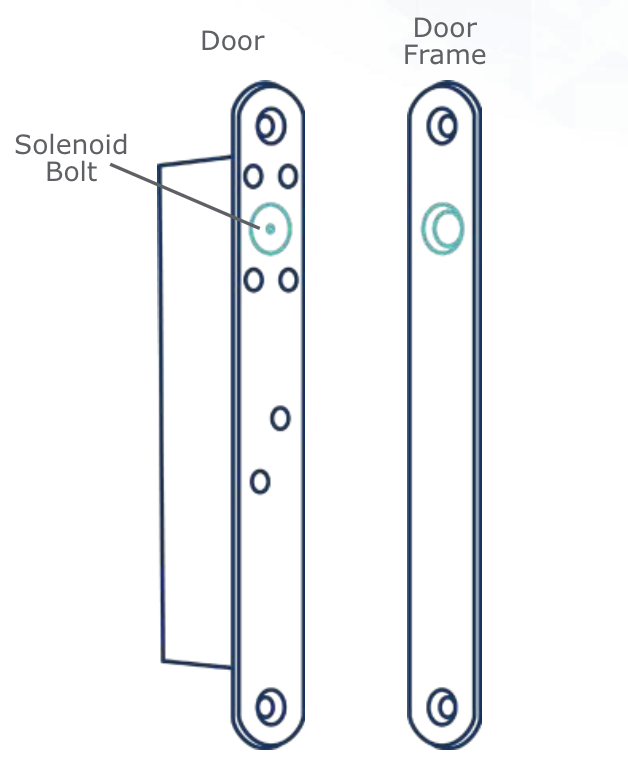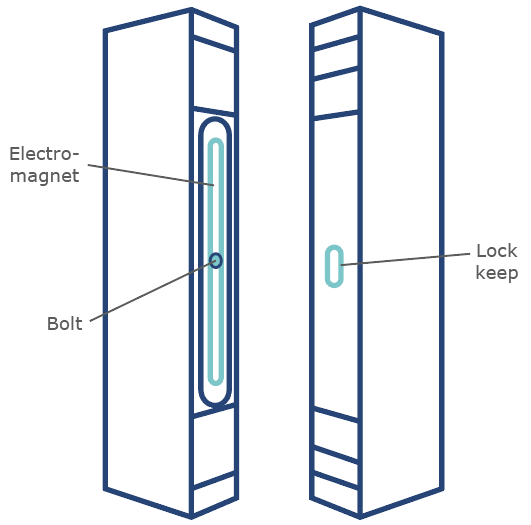VIRA20245048
maglock 20 kg/24 V - 50 kg/48 V - adjustable and/or fixed support
Scroll to learn more
Let’s start simple. Locks are devices that secure some kind of door or entryway in order to control which individuals can gain access. There are a huge amount of different types of locks in the world, each with its own advantages and disadvantages. Most people are familiar with mechanical locks, like the ones usually used on the exterior doors of houses. These are controlled by a physical key or lever which activates a release mechanism inside the lock.
Meanwhile, electronic locks are controlled by electric current. There are different types of electronic lock which use different methods to secure the door. These include magnets, metal catches, and motorised bolts.
There are many benefits to using electronic locks instead of mechanical locks. For example, as there is no physical keyhole in an electric strike or magnetic lock, so the lock cannot be picked. Electronic locks are also automated, whereas someone must remember to secure a traditional lock, leaving a greater potential for human error.
Electronic locks are designed for use with access control systems. These might be online or standalone systems. The primary benefit of access control is that it makes it simple to ensure that only authorised people can enter restricted areas. It is expensive and time-consuming to cut new keys for every person who needs one, and difficult to keep track of who has which keys. With electronic locks and an access control system, users and their credentials can be easily added, changed, or removed.
A further benefit of electronic locks is the monitoring and visibility than it offers. When a door is opened by a traditional lock and key, there’s no way to tell who used it and when. Electronic locks can be monitored, and an event log maintained to track exactly who is going in and out of areas at particular times.
There are four main types of electronic locking devices:
Each uses a different method to hold the door secured. Each has its own advantages and disadvantages and different locks are better suited to different doors and buildings. Download our brochure for a simple overview:
Electro-magnetic locks consist of two main parts: an electro-magnet and an armature plate. The armature plate is attached to the door leaf itself, while the magnet is attached to the door frame. When power is applied, and electric current runs through the circuit, the magnet turns on and creates a powerful magnetic field. The armature plate is strongly attracted to the magnet, and this attraction force holds the door closed. When power is removed, the magnetic field drops and the door can be freely opened.
Electro-magnetic locks are particularly suited to emergency exits and fire doors which have to allow free egress in an emergency, and glass doors which cannot have electric strikes fitted.

Electric strikes consist of two main components: a powered latch and a faceplate. Strikes come in both fail safe and fail secure models, which essentially differ depending on whether the strike activates when power is turned on or when power is turned off.
The strike’s faceplate is fitted into the door frame and catches the powered latch or bolt which is fitted into the door leaf. When the strike is activated by either the application or removal of power, it flicks back to release the latch or bolt from the door and allow the door to open.
Strikes are useful in a number of contexts where other types of lock are not suitable:

Solenoid bolts are a type of electronic lock that use electric current to drive a bolt into the lock keep. Typically, the bolt and its driver are installed in the door leaf itself, and the lock keep is fitted to the door frame.
A solenoid is a type of electro-magnet. In a solenoid bolt, it is this electro-magnet which is used to throw the bolt into its keep and back again. Solenoid bolts can be fail safe or fail secure, depending on whether the door is triggered to lock or unlock when power is applied or removed.
Solenoid bolts can be used on wooden, metal, or steel doors, and can be fitted into the long side of the door or the short top-side of the door. If a door is very narrow in its depth, a solenoid bolt can be ideal where an electro-magnet or an electric strike would be unsuitable.

Shearlocks are a type of electronic lock that combines an electro-magnetic lock with a motorised dead-bolt. When power is applied to the electro-magnet, it creates a magnetic field which strongly attracts the armature plate. In addition, when the door is locked, a bolt slides from the door into the keeper, which can either be fitted into the door frame or into the floor underneath the door.
The combination of electro-magnet and the additional bolt means that the holding force of shearlocks is often very high. However, because of the bolt, the two sides of the shearlock must be exactly and perfectly aligned for the lock to work. Over time, it is common for doors, frames, and the lock components to misalign, which can result in the shearlock not working as expected.

Electronic locks can be either fail safe or fail secure. Some types are definitively one or the other, such as electro-magnetic locks, which are fail safe by their nature. Others, like electric strikes, may be one or the other or adjustable depending on the needs of the project.
Fail safe means the lock opens when power is turned off. Fail safe locks are mainly used to ensure safe egress in an emergency, as if power is cut, the door will swing freely and allow people to exit.
Fail secure means the lock opens when power is turned on. In the event of a power cut, the door will therefore remain locked and keep the assets inside protected.
HOLDING FORCE
Holding force is a measure of the strength of a lock. Measured in kilograms or pounds, holding force indicates the amount of weight that would be required to break the lock.
MONITORED LOCK
Locks which are monitored are equipped with sensors which indicate the status of the lock. Monitoring allows for remote tracking and accurate reporting of lock status.
SURFACE/MORTICE
Surface locks are mounted on top of the existing physical infrastructure such as doors and door frames. Mortice locks are mounted embedded into the door or frame.
SINGLE/DOUBLE
Single maglocks consist of just one powered magnet. Meanwhile, double maglocks have two powered magnets in the same housing, doubling the holding force of the lock.
FIRE RATED
Fire rating is a certification given to locks which can withstand fire for certain periods of time. In the UK, EN14846 is the relevant regulation for fire resistance in locks and latches.
SIDE LOAD
Side load or pre-load is the force exerted on the keeper of a lock by an external force pushing on the door. Many locks cannot operate under side load.
CONTINUOUS CURRENT
Continuous or constant current is an electronic current running in one direction only, and is a steady rather than pulsating current.
METAL OXIDE VARISTOR
Locks equipped with a metal oxide varistor (MOV) are protected from surges of voltage. They help to ensure power and locking are consistent and reliable.
FAIL SAFE/FAIL SECURE
Fail safe locks are locked when power is applied, and unlocked when power drops. Fail secure locks are locked by default when power is off, and only unlock when power is applied.
ADJUSTABLE/FIXED JAW
Locks with an adjustable jaw can adapt slightly for doors which have a tendency to expand or contract. Fixed jaw means the lock cannot be adjusted in this way.
IP RATING
IP rating measures ingress protection. The first digit is measured from 0-6 and the indicates protection from solids, such as dust. The second digit is measured from 0-8 and indicates protection against liquids.
IK RATING
IK rating measures protection against mechanical impact. The scale runs from 1-10, with 10 the highest rating and protecting against a force of 20 joules of mechanical impact.
Notifications